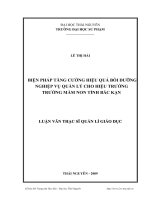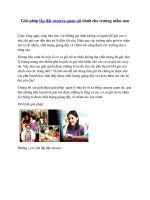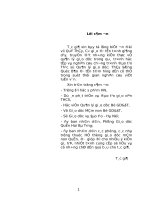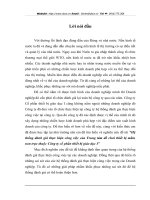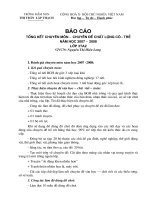mam non
Bạn đang xem bản rút gọn của tài liệu. Xem và tải ngay bản đầy đủ của tài liệu tại đây (960.7 KB, 10 trang )
<span class='text_page_counter'>(1)</span>Teaching pronunciation to children Giảng viên hướng dẫn: Nguyễn Thị Hương Lan Người thực hiện: Group 5 Vũ Thị Thu Vũ Thị Liên Nguyễn Thị Thanh Hoa Nguyễn Thị Chung Oanh.
<span class='text_page_counter'>(2)</span> Contents. Aspects of pronunciation teaching. Perception practice. Production practice. Practise stress and intonation Common pronunciation problems of Vietnamese learners.
<span class='text_page_counter'>(3)</span> 1. Aspects of pronunciation teaching stress. intonation. Rhythm. all these are not isolated from each other.. Pronunciation covers more than just phonetic symbols and rules.. Stress and intonation are often neglected by many learners..
<span class='text_page_counter'>(4)</span> Stress. Stress refers to the prominence given to certain syllables within words, and to certain syllables or words within utterances It is signaled by volume, force, pitch change and syllable length, and is often the place where we notice hand movements and other gestures.. Intonation. Intonation is about how we say things, rather than what we say. There have been three major approaches to intonation theory: + the grammatical approach + an approach that focuses on the link between intonation and attitude + the discourse approach.
<span class='text_page_counter'>(5)</span> 2. Perception practice - Using minimal pairs. Which order?. Perception practice. Same or different? Odd man out. Completion.. Pairs of words or phrases in a particular language They - day / Live - leave / Book - look You hear: “…” and you read: bit bet pet You hear: “…” and you read:bear tear ear You hear: met, meet well, will well, well You hear: bit, bit, bit, pit You hear: gate, late, fate, date, hate, rate, Kate you write: ate,ate,ate,ate, ate, ….
<span class='text_page_counter'>(6)</span> 3. Production practice Aim. • to develop the ability to produce sounds. • • Ways of production practice: • • •. Use tongue twisters/ chants/rimes.. Role plays. Listen and repeat. Fill in the blanks. Make up sentences. (last, fast, calm,dark…) Use meaningful context. Use pictures.. • • • •. Cinderella, Dressed in yellow, Went upstairs to kiss a fellow. (Pretend to walk up stairs.) Made a mistake and kissed a snake. (Pretend to kiss a snake.) • How many doctors did it take? • • • •. A: Do you want some tea? B: No, thanks. A: What about some milk? B: That sounds great.
<span class='text_page_counter'>(7)</span> 4. Practice stress and intonation Let’s discover this video to know more about how to help students be more aware of the stress, rhythm and intonation of English.. Intonation, rhythm and stress ideas. Think about the 3 sections from the video – intonation, rhythm and stress patterns. In each section there are two ideas to help students. Select the two ideas given in the video for each section..
<span class='text_page_counter'>(8)</span> Intonation section. Rhythm section. • Vi Visually mark patterns by raising eyebrows when it goes up, or asking learners to raise their heads. • Use arrows over the words on the board to mark rises and falls.. • Ask students to repeat only the words which are stressed. • Say numbers in a rhythm, then introduce words between them without changing the rhythm.. • Backchain a pattern of numbers, stressing one of the numbers more. • Mark stress clearly on the board to give them a visual record to keep. Stress patterns section.
<span class='text_page_counter'>(9)</span> 5. Common pronunciation problems of Vietnamese learners Final consonants. High percentage of mistakes. Challenging consonants. But experiencing the process. /p/ and /f/. Stress and intonation.
<span class='text_page_counter'>(10)</span> Thank you for your attention.
<span class='text_page_counter'>(11)</span>

